
Radio channel security systems.
In recent years, there has been a rapid growth in radio channel security systems.
According to various estimates, their market share today ranges from 15% to 25%, despite the fact that the wired systems segment has a head start in its development by several decades.
The attractiveness of radio channel equipment is high and, apparently, will remain so for several years, since the competition here is lower than in the segment of wired security systems, and the profitability is higher and is at the level of 25-30%.
Wireless systems have such an undeniable advantage as a reduction in installation time.
Plus the total cost of radio channel equipment and work is comparable to wired solutions for a large or medium-sized facility, and starting from a certain number of security zones, it becomes even less.
This article is intended to provide a brief introduction to wireless systems, so you will not find in-depth analysis of technical issues or comparison of existing systems on the market.
Target segments, product range issues, and signal transmission methods are the main topics of the article, which will help the reader better navigate the variety of systems existing on the market.
Typical objects using wireless security systems
The scope of wireless systems is quite extensive: from a small apartment to a large plant. Accordingly, it is necessary to divide objects into main segments.
The first segment is a local object in the residential sector, i.e. an apartment, a detached house or a garage.
The second segment includes objects that are located in a limited area (1–5 km), but are completely independent.
Examples of such objects: garage cooperatives, summer cottage or cottage villages, retail outlets.
In other words, this is a group of distributed objects for which laying cable routes between them is often a difficult task.
The third segment is individual large buildings.
Residential sector.
As practice shows, in most cases 30-36 detectors are quite sufficient for residential facilities and only in rare cases may there be a need to increase the power characteristics of the system.
But having more than 2-4 independent security sections would not be superfluous for a country house with an adjacent plot.
In residential real estate systems, qualitative rather than quantitative characteristics of the security complex are given greater weight. I would also like to note that such devices should have certain features that we are unlikely to find in systems designed for other real estate sectors.
Group of distributed objects.
Since the distance between objects is significant, and most radio channel detectors have a shorter range of alarm transmission, the equipment for such systems can usually be divided into two groups.
Some devices perform the task of collecting information from radio channel detectors within a single object. In fact, these are autonomous receivers or control panels with built-in receivers.
Another type of equipment is used to receive information from the first devices with subsequent retransmission of notifications to the central monitoring station. For most systems, these are medium-range transmitters.
To protect a single large object, you can organize a system as for the case of distributed objects.
But there is an alternative option — building a cellular architecture, in which each concentrator receives data from the detectors and retransmits the received information further to the next concentrator.
Each concentrator in such a system performs the function of a repeater. In case of loss of communication with the initially specified node, the concentrator can transmit a notification through other concentrators of the system.
Features of signal transmission of wireless security systems
Most systems have a declared range between the receiver and the detector from 200 to 600 m in direct visibility.
It is known that the operating range of a radio device depends on many factors, and in real conditions is always less than the passport value, which reflects the case of the receiver and transmitter being located in direct visibility.
Experience shows that the range of the radio channel for most systems is quite sufficient to cover residential properties. If a problem with the passage of a radio signal occurs at the site, a repeater is used.
For a large site, the range of the radio channel begins to play a significant role, as well as the issues of its diagnostics.
Anyone familiar with the setup of radio channel equipment knows that the reliability of the entire system directly depends on how competently the diagnostic procedure is carried out.
The issue of the methods of signal transmission used in the systems cannot be ignored.
There are two main methods: unidirectional or bidirectional signal transmission.
In all two-way systems, the receiving device does not poll the detectors, as many may assume by analogy with wired systems, but is in the mode of receiving notifications with subsequent transmission of an acknowledgement signal.
If the acknowledgement signal does not reach the detector, the detector transmitter will increase the test signal transmission frequency.
There is an additional method to increase the probability of message delivery: increasing the transmitter power in the detector and/or switching to another frequency channel in the permissible frequency band. In systems with one-way transmission, the acknowledgement signal from the receiver is absent.
To increase reliability, such systems use another method: not one message is sent, but a group of messages. Moreover, each detector has a different time shift between messages.
If at some point in time the signals from two transmitters are completely synchronized, at the following points in time the signals from these transmitters will have a time shift. Therefore, the receiver will register two messages, and no signal loss will occur.
However, hardly anyone would argue that a two-way radio channel is more reliable, although, by and large, the end user does not care what communication principle is embedded in the system that protects him. The question is in what cases the user is willing to pay for it.
If we are talking about a threat to human life, for example, a fire in a shopping center or hospital, then the answer is obvious. In the case of a security alarm at a summer house or in an apartment, the probability of signal loss at the time of theft is not so great.
Apparently, this explains the fact that all companies that have been developing radio systems for more than 10 years for this market segment are in no hurry to switch to duplex communication between the receiver and the detector.
Which cannot be said about radio channel remote controls and key fobs.
Many control panels that only receive signals from the detector are capable of supporting control devices with duplex communication due to the built-in transmitter.
Security detectors
Currently, all types of wired detectors have their own analogue in radio channel design.
If a few years ago it was difficult to find such types of security devices as magnetic contact detectors with hidden installation, outdoor passive infrared (PIR), position detectors for the protection of museum valuables, today it is more difficult to find manufacturers who do not manufacture them.
But, naturally, PIC detectors are still the most popular. There is no point in dwelling on this group of equipment, since wireless detectors are in no way inferior to their wired counterparts in terms of efficiency and reliability.
Prevention of emergency situations
The most common item in the range of many manufacturers is a water leak detector. This fact indirectly reflects statistics, according to which the greatest number of cases of damage or destruction of property occurs as a result of accidents in water supply systems.
It should be noted that timely detection of water leakage is a task that is certainly necessary, but not sufficient. Its logical conclusion is automatic shut-off of water supply. Manufacturers solve it using various methods.
For example, some companies produce radio channel modules that control electromechanical shut-off valves upon receiving a command from the central unit. Others produce special receiver-controllers that can operate autonomously or together with the control panel.
The group of emergency detectors also includes natural gas and carbon monoxide leak detectors and a temperature detector.
Emergency call
Miniature transmitters are used for emergency calls, which can be worn on the neck, in a pocket, or even on the hand using a special bracelet.
There are even transmitters in the form of a wristwatch with a waterproof case, which you can wear in a bath or pool. Some systems have the ability to establish a two-way hands-free audio connection with a person who needs help.
To support this function, a microphone and speaker are built into the control panel. You can also find a device that has an additional option for monitoring a person's position — a radio transmitter worn on the belt with a tilt sensor relative to the vertical axis.
If a person falls or loses consciousness, the sensor will be triggered after a specified time and the control panel will send a corresponding notification.
Control of actuators
There are two clear ways to control the devices.
The first traditional option is control via a radio channel. In fact, the controlled module is a receiver with a relay output.
The second method is based on the transmission of commands (X10 protocol) via the existing power wiring at the facility.
The methods of controlling executive modules can be different: switching on according to various system events, for example, when armed or according to a specified schedule.
Controlled modules are available in various modifications that can be used to control lighting devices, household appliances or devices with inductive loads.
User capabilities
This area relates to a greater extent to systems that were developed for use in the residential real estate sector.
The user is most interested in the communication capabilities of the system, methods for implementing remote and local control. The end buyer's assessment of the system depends on how well this set of functions is thought out.
Note that in some systems, a regular mobile phone can be used as a remote control keyboard, i.e. receive detailed voice and SMS notifications, listen to and record the current sound environment, change system modes, control the home automation system, and much more.
From the point of view of local control, systems with a built-in voice guidance unit are certainly a clear advantage. World experience shows that about 85% of false calls are caused by users.
Some manufacturers have come to the conclusion that most systems provide scanty information and in a form that is difficult to perceive. Therefore, these companies have built a voice guidance module into their systems.
The most consistent developers have taken another step — they have implemented in the system a two-way radio communication between the external keyboard and the control panel, which can be hidden in a secluded place, thereby increasing the security of the entire system.
But the most important thing is that this keyboard also supports voice messages.
Transmission of notifications
You can develop a system for a large number of zones, sections, organize duplex communication between radio devices, use the most advanced technology for detecting an intruder in the detectors, etc.
But all this will be useless hardware if you forget about the means of delivering alarm notifications to their destination. Therefore, many manufacturers have paid the closest attention to communication issues.
The rapid development of cellular networks has opened up new prospects for the development of notification transmission systems. Below are brief explanations of these channels.
GSM Voice.
An analog (voice) channel is used, through which normal voice communication between GSM network subscribers occurs. The most well-known DTMF protocol is Ademco Contact ID.
GSM DATA/CSD.
Digital data transmission channel at a speed of 9.6 kbps. This method is characterized by an almost 100% probability of message delivery.
Connection establishment time is about 20 seconds. CSD is charged per minute, as for the GSM voice channel.
TCP/IP GPRS.
The most advanced method is based on packet data transmission, based on the TCP/IP protocol.
The method is characterized by high data transfer speed, allows to control the communication channel.
Some companies are starting to use the SIA IP standard in the facility equipment and the central monitoring station (server part), which is the only world standard for using the Internet in the field of security.
Alexor wireless security alarm system (DSC)
The ALEXOR system uses only wireless components: sensors, control panels, keyboards. The new DSC PC9155 control panel with a two-way radio channel works with all existing and new detectors, sirens, key fobs, keyboards, etc. with a frequency of 433 MHz.
Communication with the monitoring center can also be carried out wirelessly: via GPRS, GSM and WiFi IP channels.
Alexor is a complete solution for creating a wireless security system at the facility.
It includes the following wireless equipment:
- PC9155 control panel;
- WT5500 text LCD remote control;
- sirens with feedback for outdoor installation (WT4911) and indoor installation (WT4901);
- Detectors: passive IR volumetric detectors (WS4904W and WS4904PW), combined optical-electronic smoke and heat detector (WS4916), door contacts (WS4945 and WS4975), glass break detector (WLS 912), carbon monoxide detector (WS4913), water leak detector (WS4985);
- Key fobs: four-button key fob (WS4939), proximity key fob for arming and disarming (PT4), key fob with feedback with system status indication on the LCD display (WT4989);
various types of communicators that allow the use of GSM, GPRS and IP channels for data transmission.
8–64-zone DSC control panel PC-1864NK (DSC)
Has 8 sections, 8 zones on the panel board.
The DSC PC-1864NK has 64 wired (7xPC5108) and 32 wireless zones (when using the PC-5132 receiver). All zones can be programmed as security or fire zones.
The panel has 4 programmable outputs with the ability to expand their number to 14. There is also the possibility of local and remote communication with a computer.
The expansion module for 32 wireless zones DSC PC-5132NB provides connection of up to 32 different wireless DSC detectors, up to 16 wireless control key fobs.
The radio signal frequency is 433 MHz.
Together with the receivers RS-5132, RF-5108, which, in turn, are compatible with the DSC control panels, a wireless photoelectric smoke detector DSC WS4916 combined with a thermal (57 °C) can be used.
The detector has a built-in siren — 85 dB, a test button.
The coverage area is up to 80 sq. m.
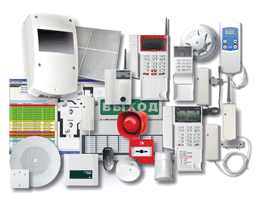
Intra-facility radio system of fire alarm and addressable analog fire alarm and notification STRELETS® (Argus-Spectrum)
The radio system has a two-way Argus-Dialogue® protocol (between all radio devices), dynamic routing of signal delivery, 10 radio frequency channels in the 433 and 868 MHz ranges. Automatic selection of a backup channel (free from interference).
The programmable period of control signal transmission is from 12 seconds to 2 minutes.
Communication range (in open visibility): 600 m within a microcell, 1000 m between microcells and 15000 m taking into account retransmission.
System capacity: 512 radio alarms and process detectors; 256 radio channel sirens, voice alarms, relay modules, control devices, etc.; 16 radio expanders; 16 routers.
The service life of radio detectors: 5 years (main battery) + 2 months (backup battery).
Operating temperature range from -30 to +550C.
The system includes an addressable analog fire alarm and a wireless voice notification subsystem («Orfey-R»).
The system can be integrated with wired fire alarm systems, access control, video surveillance, etc.
Transmission of information from the facility via all communication channels: GSM, Ethernet, radio channel, dial-up telephone lines, busy subscriber lines.
The system complies with the provisions of Federal Law No. 123 «Technical Regulations on Fire Safety Requirements», GOST R 53325-2009.
Included in the «Bulletin of Technical Security Equipment Recommended for Use by Off-Departmental Security», approved for use at restricted facilities.
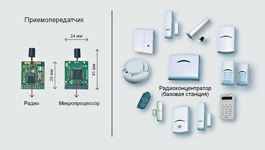
Easy Series wLSN (BOSCH)
The Easy Series security panel with wireless wLSN devices for 32 zones is an example of user comfort in working with the system, flexible installation options in programming and reliability of message transmission in a wireless network.
Attractive design, radio remote controls with system status indication, wireless volumetric detectors with protection from animals up to 45 kg and transmission of voice messages about alarms to a mobile phone allows the user to feel the correctness of their choice.
Automatic search for wireless network devices, communication range up to 1000 m, signal strength determination using a wLSN radio tester or detector LEDs, pre-programming templates and the ability to configure the system on a laptop allow the installer to quickly install and configure the system.
Bidirectional communication in the 868 MHz range using frequency and time division multiplexing (TDMA) allows 99 systems to operate simultaneously without packet loss or collisions.
The duty cycle method and energy saving mode increase battery life up to 5 years.
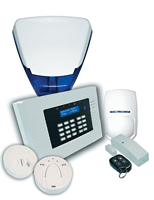
Enforcer 32WE (Pyronix)
The system is designed to protect small and medium-sized real estate.
The system capacity is 32 radio channel detectors and 32 control key fobs. Built-in control keyboard with blue LCD display.
Built-in siren. 2 wired zones and 3 programmable outputs.
Built-in uninterruptible power supply.
Battery life is 24 hours.
The range between the detector, radio key fob and control panel is 600 m in direct visibility. The system uses duplex communication with all types of detectors and control devices.
Detector types: passive infrared immune to animal movement, magnetic contact with additional input, smoke detector, carbon monoxide detector.
The PIR detector has digital processing, spherical lens.
A radio channel outdoor siren is used as an additional device of the warning system.
The Enforcer 32WE control panel has a built-in GSM communicator.
Alarm notifications are transmitted via an analog GSM channel or GPRS channel to the Pyronix IP server.
Additionally, it is possible to send SMS messages to the user.
The system is programmed using the built-in keyboard or a personal computer
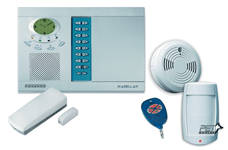
MG6160 (Paradox Security Systems)
The system is designed to protect residential real estate.
The system capacity is 32 radio channel detectors and 16 control key fobs.
Built-in control keyboard with LCD display.
Built-in siren. 2 wired zones and 2 programmable outputs.
Built-in telephone communicator.
Support for 8 X10 home automation modules.
Built-in uninterruptible power supply.
Battery life – 24 hours.
The range between the detector and the control panel is 180 m in direct visibility.
The MG-RPT1 repeater is used to increase the range.
The system uses one-way communication with all types of detectors.
Duplex communication is supported with the MG-REM2 control key fob, control keyboard, programmable output module and siren.
Detector types: 2 models of passive infrared detectors (PIR), outdoor PIR, magnetic contact with an additional input.
The control panel has a compact case, stylish design, electronic clock with a dial, built-in FM receiver.
The system is programmed from the built-in control keyboard or a personal computer.
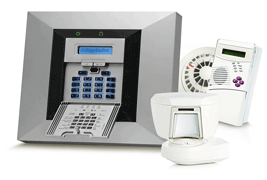
PowerMax Pro (Visonic)
The system is designed to protect residential real estate. The system capacity is 28 radio channel detectors, 8 control key fobs, 4 security sections.
Built-in control keyboard with blue LCD display.
Built-in GSM/GPRS module.
TCP/IP module support.
Built-in siren, microphone, speaker. 2 wired zones, 1 programmable output.
Support for a module with 5 relay outputs.
Built-in telephone communicator.
Support for 16 X10 home automation modules.
Built-in uninterruptible power supply.
Battery life — up to 48 hours (2 cassettes).
The range between the detector and the control panel is 200 m in direct visibility.
Up to 16 MCX-600 repeaters.
The system uses one-way communication with all types of detectors.
Duplex communication is supported with the 6-button MCT-237 control key fob, MKP-150 control keypad and siren.
Detectors: 12 types of security detectors for indoor installation, outdoor PIC with mirror optics and protection against masking, 5 types of emergency detectors.
Full control via mobile phone.
Voice and SMS messages.
Remote listening via phone.
Voice prompts.
System programming is carried out from the built-in control keyboard or personal computer.
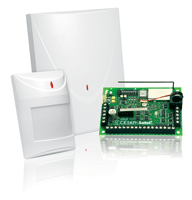
Wireless fire and security alarm ABAX (Satel)
This wireless solution is designed to expand the capabilities of a wired fire or security alarm system from any manufacturer by adding controllers and wireless security sensors, alarms and/or fire detectors.
ABAX uses the latest technologies, thanks to which constant two-way radio communication with encryption of transmitted data is carried out between the system devices and a level of security is guaranteed, previously achievable only in traditional wired systems, and a minimum level of energy consumption is ensured.
Data is transmitted at a frequency of 868.3 MHz with protection against jamming.
The wireless system is based on Satel ACU-100 controllers, each of which can control the operation of up to 48 wireless devices (sensors, detectors and alarms) and is configured using an LCD keyboard or a computer.
To configure the controller and the entire ABAX system as a whole, the Russified DLOAD software is used, which is included in the equipment delivery set.
For the ABAX system, Satel produces wireless heat and smoke fire detectors.
Other features of Satel solutions include wireless combined (IR + microwave) motion sensors, where the microwave channel is activated only after the IR sensor is triggered, ensuring minimal low power consumption by the microwave head.
Each sensor can operate on one battery for 3 years.
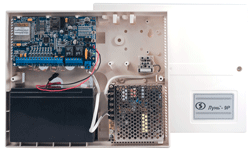
Lun-9R (Security and Safety) PPPK
Field-based fire alarm system.
It is intended for organizing control panel (technical) security and fire protection of small and medium-sized facilities (office premises, shops, apartments).
«Lun-9R» has 8 security or fire loops (with definition of three states of a fire loop), control of the presence of an alternating current network of 220 V and discharge of the battery and control of its charge.
The presence of a siren is controlled.
BELL output for connecting a siren with a current of up to 900 mA. The controlled output of the sensor power supply has a load capacity of 500 mA.
The device allows you to perform all functions of remote control and status reporting on request from the control panel, has 2 additional relay outputs. You can use two SIM cards in the device.
«Lun-9R» transmits messages via a telephone line, voice and GPRS channels of the GSM network.
The algorithm for protection against false alarms is as follows: when the fire detector is triggered for the first time, «Lun-9R» resets the power supply to the fire detectors.
If after the power supply is restored the sensor is triggered again within 1 minute, this signal is immediately transmitted to the central monitoring station. Thus, false alarms do not reach the central monitoring station.
«Ladoga RK» radio channel subsystem (ZAO «Rielta»)
PPKOP «Ladoga-A» — radio subsystem of security and fire alarm.
Provides two-way radio exchange with dynamic information coding (protocol «Rielta-Contact-R»), frequency range 433 MHz, 4-frequency letters, up to 8064 detectors in the zone of mutual radio visibility, automatic transition to the backup frequency.
The subsystem includes the radio expander «Ladoga BRSHS-RK», a radio repeater, up to 16 radio channel detectors: infrared, glass break, magnetic contact, fire smoke, fire manual, as well as manual alarm.
Operating range in open space – at least 200 m without using a repeater. Detectors are powered by two controlled batteries.
The duration of detector operation from the main battery is at least 5 years.
Combination of up to 5 subsystems in one Ladoga-A control panel.
The ability to simultaneously control radio channel, wired addressable and wired non-addressable detectors by one control panel.
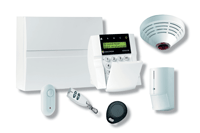
JA-80 OASiS (Jablotron Alarms)
The wireless alarm system OASiS, manufactured by the Czech company JABLOTRON ALARMS, is based on the latest achievements of GSM/GPRS and IP technologies.
The system combines protection from robbers and fire alarm (50 zones), has a garage door opening function and a doorbell function.
The system is similar to a LEGO constructor and is just as easy to implement any tasks at the user's request.
The cornerstone and brain of the system is the control panel with a modular architecture, allowing you to easily add the necessary functions.
Working with the system requires entering a code — up to 50 contactless cards for users, up to 50 access codes.
The OASiS alarm system can combine wired and wireless zones.
When using wireless zones, the installation has a minimal impact on the interior of the house. All detectors are regularly self-tested and the housings are protected from opening.
Via the GSM network, you can receive full information from the system (SMS to 8 numbers) and also control it. system from a mobile phone or via the Internet.
To ensure a higher level of security, the listed communicators can be combined.
The system has the ability to transmit all the necessary information to the security console and is accepted for connection by most central control centers.

Добавить комментарий